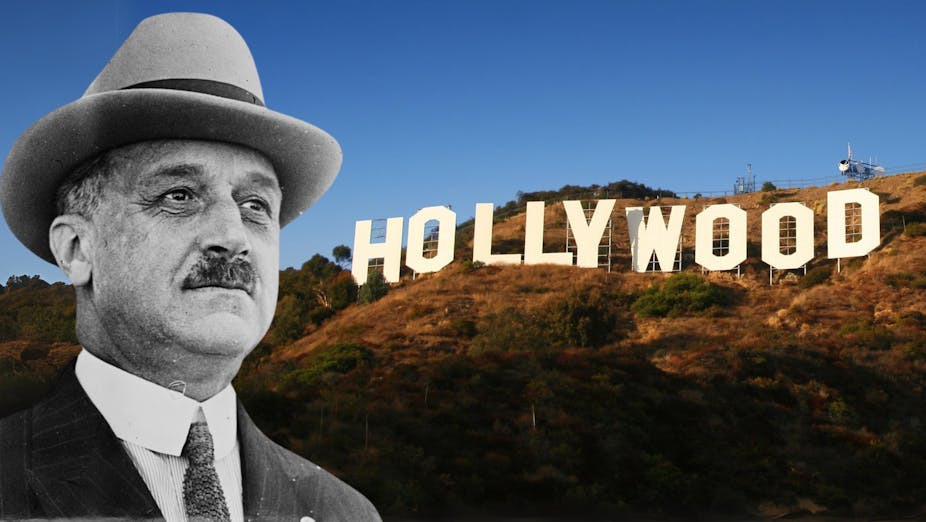What do Charlie Chaplin, Walt Disney and Frank Capra have in common? The same Italian banker.
Early Hollywood movies have been widely studied and investigated. But surprisingly little is known about their financing, and how the contributions of low-income immigrants helped shape the Hollywood film industry – especially Italians.
Approximately 4 million people from disadvantaged backgrounds had arrived in the US via Ellis Island by 1920. They have often been portrayed in film as delinquents of New York’s Lower East Side. This stereotypical character assigned to Italians persisted for decades, and was revived by the popularity of mafia movies and TV shows such as The Sopranos.
These portrayals have progressively influenced public perceptions and attitudes toward Italian immigrants and their descendants. But in reality, early Italian immigrants were central to the establishment and growth of the American economy. One visionary financier, whose name is not (yet) as well known as it should be (and that our upcoming documentary research aims to spotlight) saw an opportunity to change the narrative.
AP Giannini
Amadeo Peter Giannini (1870-1949), commonly known as AP, was a popular figure in San Francisco. He was the son of Italian immigrants and the founder of the Bank of Italy, which he progressively grew into the Bank of America. Through this institution, Giannini contributed to the birth of projects such as the Golden Gate Bridge (1937), the 1948 Marshall Plan (in which the US provided western European countries with economic aid following the second world war). He was also an important player in the birth of Hollywood.
Sometimes known as the “people’s banker” or the “gentleman banker”, Giannini started out working in agriculture through his small family business. Having inherited some shares from his father-in-law in a small bank he was able to see that the system was constructed by and for the wealthy.

Giannini believed that immigrants chasing the American dream, like his own father and mother from Liguria, could be an important resource for the US. He believed that ethical banking would allow general social mobility, and with it the opportunity to finance young industries – such as cinema.
Giannini founded the Bank of Italy in 1904 as a small bank in San Francisco. There, minorities who were traditionally excluded from any form of financing, such as Italian, Chinese, Irish, Mexican and Portuguese people, could deposit their savings – no matter how modest. The bank was more than a place where to put your salary. It was an entry way into American institutions enabling such migrants to borrow money ethically, often on a handshake, and grow.
Not only did these deposits allow the migrant community to settle and flourish, but it meant that employment could be created by investing in immigrant businesses.
Changing the game
The most promising of these businesses was the movie studio system. The Bank of Italy began to lend money to young filmmakers and producers in Hollywood. Many of these filmmakers didn’t qualify for business loans, but as Giannini believed in building not only an industry, but a community, the bank would extend personal loans.
Producer Sol Lesser, best known for his Tarzan movies, is a case in point. While still a minor, he received a private loan undersigned by Giannini himself to buy seats for his first Nickelodeon movie theatre. This was the beginning of his path towards becoming an influential producer.
Giannini’s little bank figured out the lending system that has since become the industry standard. As Warren Sherk of the Margaret Herrick Library at the Academy of Motion Pictures Arts and Sciences explains in our upcoming documentary AP Giannini: Bank to the future, banks initially used film negatives as collateral, believing they held value since they could be used to make sellable prints and therefore allow them to recover their investment were the producers unable to fulfil the loan payments. But this approach prevented filmmakers from accessing, printing and distributing their own films.
As a solution, Giannini instead came up with a new protocol for film loans where the bank would secure the rights and distribution income of two films that had already been produced as security for the loan of the film financed by the bank. He also began what is now known as “attachment” – the practice of having a star attached to a film in order to secure ticket sales
With this new financing model, the bank’s risk was minimised, the filmmakers were able to meet the conditions and the Hollywood industry thrived. Classics such as The Tramp (1915), Snow White and the Seven Dwarfs (1937) and Gone With the Wind (1939) were financed through Giannini. Filmmakers including Charlie Chaplin, Frank Capra, Walt Disney and Alfred Hitchcock, and organisations such as United Artists and even the Academy itself were backed by Giannini’s revolutionary vision.
The transparency of Giannini’s bank was central to his success and saved it during some of the most challenging financial times of the 20th century. Its stability was nourished by the constant influx of immigrant money, deposited by those yearning to become respected American citizens with a bank account, a privilege that was extended to women in 1920 when Bank of Italy opened the first women’s department in the country.
So much so that, as Sherk explains, it was immigrants’ nickels and dimes, deposited in Bank of Italy and Bank of America, that funded the early Hollywood film industry.

Looking for something good? Cut through the noise with a carefully curated selection of the latest releases, live events and exhibitions, straight to your inbox every fortnight, on Fridays. Sign up here.

